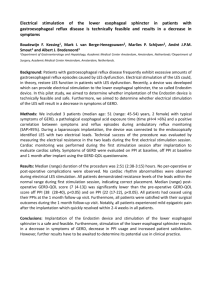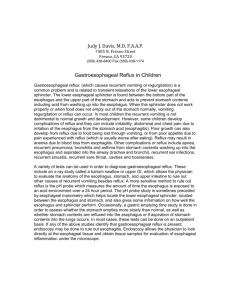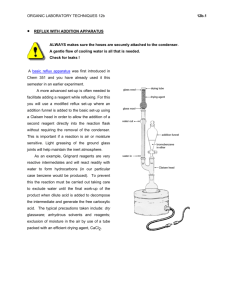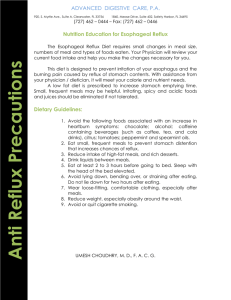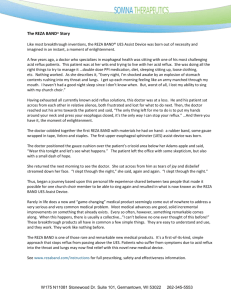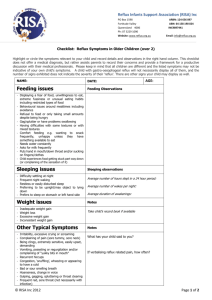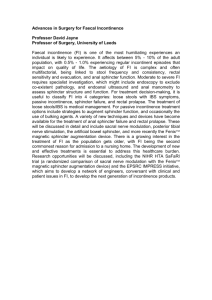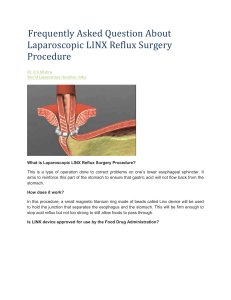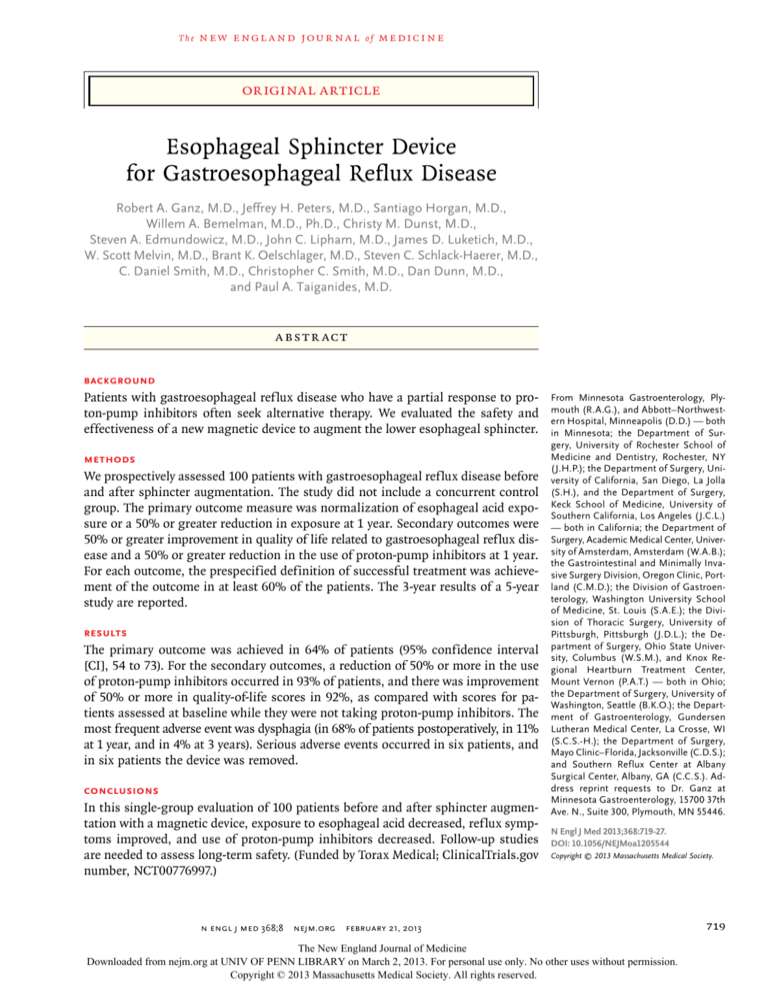
The
n e w e ng l a n d j o u r na l
of
m e dic i n e
original article
Esophageal Sphincter Device
for Gastroesophageal Reflux Disease
Robert A. Ganz, M.D., Jeffrey H. Peters, M.D., Santiago Horgan, M.D.,
Willem A. Bemelman, M.D., Ph.D., Christy M. Dunst, M.D.,
Steven A. Edmundowicz, M.D., John C. Lipham, M.D., James D. Luketich, M.D.,
W. Scott Melvin, M.D., Brant K. Oelschlager, M.D., Steven C. Schlack-Haerer, M.D.,
C. Daniel Smith, M.D., Christopher C. Smith, M.D., Dan Dunn, M.D.,
and Paul A. Taiganides, M.D.
A BS T R AC T
BACKGROUND
Patients with gastroesophageal reflux disease who have a partial response to proton-pump inhibitors often seek alternative therapy. We evaluated the safety and
effectiveness of a new magnetic device to augment the lower esophageal sphincter.
METHODS
We prospectively assessed 100 patients with gastroesophageal reflux disease before
and after sphincter augmentation. The study did not include a concurrent control
group. The primary outcome measure was normalization of esophageal acid exposure or a 50% or greater reduction in exposure at 1 year. Secondary outcomes were
50% or greater improvement in quality of life related to gastroesophageal reflux disease and a 50% or greater reduction in the use of proton-pump inhibitors at 1 year.
For each outcome, the prespecified definition of successful treatment was achievement of the outcome in at least 60% of the patients. The 3-year results of a 5-year
study are reported.
RESULTS
The primary outcome was achieved in 64% of patients (95% confidence interval
[CI], 54 to 73). For the secondary outcomes, a reduction of 50% or more in the use
of proton-pump inhibitors occurred in 93% of patients, and there was improvement
of 50% or more in quality-of-life scores in 92%, as compared with scores for patients assessed at baseline while they were not taking proton-pump inhibitors. The
most frequent adverse event was dysphagia (in 68% of patients postoperatively, in 11%
at 1 year, and in 4% at 3 years). Serious adverse events occurred in six patients, and
in six patients the device was removed.
CONCLUSIONS
In this single-group evaluation of 100 patients before and after sphincter augmentation with a magnetic device, exposure to esophageal acid decreased, reflux symptoms improved, and use of proton-pump inhibitors decreased. Follow-up studies
are needed to assess long-term safety. (Funded by Torax Medical; ClinicalTrials.gov
number, NCT00776997.)
From Minnesota Gastroenterology, Ply­
mouth (R.A.G.), and Abbott–Northwestern Hospital, Minneapolis (D.D.) — both
in Minnesota; the Department of Surgery, University of Rochester School of
Medicine and Dentistry, Rochester, NY
(J.H.P.); the Department of Surgery, University of California, San Diego, La Jolla
(S.H.), and the Department of Surgery,
Keck School of Medicine, University of
Southern California, Los Angeles (J.C.L.)
— both in California; the Department of
Surgery, Academic Medical Center, University of Amsterdam, Amsterdam (W.A.B.);
the Gastrointestinal and Minimally Invasive Surgery Division, Oregon Clinic, Portland (C.M.D.); the Division of Gastroenterology, Washington University School
of Medicine, St. Louis (S.A.E.); the Division of Thoracic Surgery, University of
Pittsburgh, Pittsburgh (J.D.L.); the Department of Surgery, Ohio State University, Columbus (W.S.M.), and Knox Regional Heartburn Treatment Center,
Mount Vernon (P.A.T.) — both in Ohio;
the Department of Surgery, University of
Washington, Seattle (B.K.O.); the Department of Gastroenterology, Gundersen
Lutheran Medical Center, La Crosse, WI
(S.C.S.-H.); the Department of Surgery,
Mayo Clinic–Florida, Jacksonville (C.D.S.);
and Southern Reflux Center at Albany
Surgical Center, Albany, GA (C.C.S.). Address reprint requests to Dr. Ganz at
Minnesota Gastroenterology, 15700 37th
Ave. N., Suite 300, Plymouth, MN 55446.
N Engl J Med 2013;368:719-27.
DOI: 10.1056/NEJMoa1205544
Copyright © 2013 Massachusetts Medical Society.
n engl j med 368;8 nejm.org february 21, 2013
The New England Journal of Medicine
Downloaded from nejm.org at UNIV OF PENN LIBRARY on March 2, 2013. For personal use only. No other uses without permission.
Copyright © 2013 Massachusetts Medical Society. All rights reserved.
719
The
n e w e ng l a n d j o u r na l
T
he fundamental pathologic abnormality in gastroesophageal reflux disease
is an incompetent lower esophageal sphincter.1-3 First-line therapy for gastroesophageal
reflux disease is acid suppression, usually with
proton-pump inhibitors. Although effective, proton-pump inhibitors provide incomplete control
of reflux symptoms in up to 40% of patients.4-6
A partial response can occur because these drugs
do not address an incompetent sphincter or prevent reflux; consequently, some patients have only
partial relief from symptoms and seek alternative
treatment if their quality of life is compromised.
At present, the only established option for these
patients is antireflux surgery, typically Nissen
fundoplication. However, the acceptance of surgery is limited, owing to potential side effects,
such as abdominal bloating, increased flatulence,
inability to belch or vomit, and persistent dysphagia.7,8
Augmentation of the esophageal sphincter
with a magnetic device may provide an alternative treatment for patients who have incomplete
symptom relief with proton-pump inhibitors or
who are reluctant to undergo surgical fundoplication.9-11 The aim of magnetic sphincter augmentation is to improve the barrier function of
the sphincter without altering the hiatal and
gastric anatomy or interfering with swallowing,
belching, or vomiting. The feasibility of this
concept was shown in a pilot study.11 We report
the 3-year outcomes of a 5-year clinical trial assessing the safety and effectiveness of a magnetic device for sphincter augmentation.
ME THODS
STUDY DESIGN
The study was designed by the sponsor (Torax
Medical), the investigators, and the Food and Drug
Administration as a 5-year prospective, multicenter,
single-group evaluation of a magnetic sphincter
device. There was no concurrent control group.
The primary objective of the study was to evaluate
the safety, efficacy, and direct effects of the device on exposure to esophageal acid, quality of
life, and use of proton-pump inhibitors.
PATIENTS
Between January and September 2009, a total of
13 centers in the United States and 1 in the Netherlands enrolled patients in the study. Eligible
patients were 18 to 75 years of age, had at least a
720
of
m e dic i n e
6-month history of reflux disease, and had a partial response to daily proton-pump inhibitors,
with increased exposure to esophageal acid as
confirmed by pH monitoring. Exclusion criteria
were evidence of a large hiatal hernia, esophagitis of grade C or D according to the Los Angeles
classification (in which grade A indicates one or
more mucosal breaks of ≤5 mm in length, grade
B one or more mucosal breaks of >5 mm, grade
C mucosal breaks that extend between two or
more mucosal folds but involve <75% of the circumference of the esophagus, and grade D mucosal breaks involving ≥75% of the circumference of the esophagus), a body-mass index (BMI;
the weight in kilograms divided by the square of
the height in meters) of more than 35, Barrett’s
esophagus, a motility disorder, dysphagia more
than three times a week, and allergy to titanium,
stainless steel, nickel, or ferrous materials. A complete list of inclusion and exclusion criteria is
provided in the study protocol, which is available
with the full text of this article at NEJM.org.
STUDY PROCEDURES
Baseline screening included endoscopy, pH monitoring while the patient was not taking protonpump inhibitors, barium esophagography, and
manometry. These tests, in addition to chest radiography, were repeated 1 year after implantation. Endoscopy and chest radiography were also
performed at 2 years and are planned for 5 years.
The dose and frequency of proton-pump inhibitors, along with quality of life and foregut symptoms, were evaluated at baseline and postoperatively at 1 week, 3 months, and 6 months and
annually starting at 1 year, with plans to continue annual screening for a total of 5 years.
Quality of life was measured with the use of
the Gastroesophageal Reflux Disease–HealthRelated Quality of Life questionnaire, which is
provided in the Supplementary Appendix, available at NEJM.org.12 Total scores range from 0 to
50, with higher scores indicating worse symptoms, and no minimally important difference in
scores is defined. Quality of life was assessed
both while the patient was taking proton-pump
inhibitors and while the patient was not taking
proton-pump inhibitors at baseline and then
while the patient was not taking proton-pump
inhibitors at follow-up. Patients were asked about
foregut symptoms, such as regurgitation, belching, and vomiting, before and after treatment.13
The esophageal sphincter device was implant-
n engl j med 368;8 nejm.org february 21, 2013
The New England Journal of Medicine
Downloaded from nejm.org at UNIV OF PENN LIBRARY on March 2, 2013. For personal use only. No other uses without permission.
Copyright © 2013 Massachusetts Medical Society. All rights reserved.
esophageal Sphincter Device for gerd
ed with the use of standard laparoscopic techniques by surgeons who had experience with
fundoplication. The device involves the use of
magnetic attraction through adjacent magnetic
beads, which augments the resistance of the
esophageal sphincter to abnormal opening associated with reflux.9-11 Each bead contains a
sealed core of magnetic neodymium iron boride
that produces a precise and permanent force of
attraction. The beads are connected to adjacent
beads by small wires that allow the device to
expand. The device is sized to fit around the
external diameter of the esophagus, without
compressing the underlying muscle (Fig. 1A).
The beads separate with the transport of food or
increased intragastric pressure associated with
belching or vomiting (Fig. 1B; and see Video 1,
available at NEJM.org). There were no dietary
restrictions after implantation.
END POINTS
The primary end point was the number of patients who had normalized acid exposure (total
proportion of time with a pH of <4 in a 24-hour
period, ≤4.5%) or who had a reduction of 50% or
more in the proportion of time with a pH of less
than 4, as compared with the baseline measurement while the patient was not taking protonpump inhibitors. The secondary end points,
measured separately, were the number of patients with a reduction of 50% or more in the
total score for quality of life, as compared with
the score at baseline without proton-pump inhibitors, and a reduction of 50% or more in the
dose of proton-pump inhibitors, as compared
with the baseline dose. All efficacy end points
were measured at 1 year, and the treatment was
considered to be successful if the efficacy end
points were reached in at least 60% of the patients. Safety was monitored throughout the
study period, with assessment of the rate and
type of serious adverse events related to the device or the implantation procedure.
STUDY OVERSIGHT
The institutional review board of each site approved the study protocol, and written informed
consent was obtained from all patients. The data
were analyzed by the investigators and the sponsor. A clinical events committee reviewed all adverse events. All the authors vouch for the integrity of the trial and the completeness and
accuracy of the reported data and for the fidelity
of this report to the study protocol. The first author wrote the initial draft of the manuscript,
incorporating revisions from the investigators.
The final manuscript was written by a committee
consisting of the first author, an investigator,
and a physician involved in study oversight, none
of whom were employees of the sponsor. All the
authors made the decision to submit the manuscript for publication.
STATISTICAL ANALYSIS
All end-point analyses were performed according
to the intention-to-treat principle, 1 year after implantation. Patients who did not undergo the endpoint evaluation at 1 year or who had missing data
were counted as having treatment failure. Additional clinical findings were assessed after 1 year
in post hoc analyses of available data. For esophageal acid monitoring, the median pH components
at baseline and 1 year after implantation were
compared. For quality of life, scores at baseline
with and without proton-pump–inhibitor therapy
were compared with scores after implantation
without proton-pump inhibitors, along with the
percentage of patients who said that they were satisfied with their current condition at 1, 2, and 3
years. In addition, the percentage of patients with
complete discontinuation of proton-pump inhibitors was assessed at 1, 2, and 3 years.
Continuous demographic characteristics and
baseline variables were summarized with the
use of standard descriptive statistics (i.e., means
with standard deviations and medians with
ranges). Categorical demographic characteristics
and baseline variables were summarized by
means of frequency distributions. A two-tailed,
paired Student’s t-test or the Wilcoxon signedrank test was used to compare values before and
after implantation. Differences were considered
to be significant at the 0.05 level.
Videos showing
the placement
and function of the
magnetic sphincter
are available at
NEJM.org
R E SULT S
CHARACTERISTICS OF THE PATIENTS
The study population consisted of 100 patients,
52% of whom were men, with a median age of 53
years (range, 18 to 75) and a median BMI of 28
(range, 20 to 35). The median duration of reflux
symptoms was 10 years (range, 1 to 40). The median duration of treatment with proton-pump
inhibitors was 5 years (range, <1 to 20). Each
patient had confirmed increased exposure to
esophageal acid while not taking proton-pump
n engl j med 368;8 nejm.org february 21, 2013
The New England Journal of Medicine
Downloaded from nejm.org at UNIV OF PENN LIBRARY on March 2, 2013. For personal use only. No other uses without permission.
Copyright © 2013 Massachusetts Medical Society. All rights reserved.
721
The
n e w e ng l a n d j o u r na l
of
m e dic i n e
A
Diaphragm
Esophagus
Closed position
Titanium case
Magnetic core
Magnetic device
in closed position
Stomach
Titanium arm
B
Open position
Bolus
Magnetic device
in open position
Figure 1. Magnetic Device for Augmentation of the Lower Esophageal Sphincter.
Panel A shows the magnetic device in the closed position, which helps prevent opening of the lower esophageal
sphincter and subsequent reflux. Each magnetic bead rests on adjacent beads to prevent esophageal compression.
Panel B shows the device in the open position, which allows transport of food, belching, and vomiting.
inhibitors (median percentage of time with pH
<4 during a median pH-monitoring period of 45
hours, 10.9%; range, 4.8 to 25.4); the median DeMeester score was 36.6 (range, 16.3 to 83.8). The
DeMeester score is a composite score of factors
quantified during a 24-to-48-hour pH study, with
a score of 14.7 or more indicating abnormal re722
flux. Factors include the percentage of time that
the pH was less than 4 during the assessment
period, during the time in an upright position,
and during the time in a supine position; the total number of reflux episodes; the number of
episodes lasting more than 5 minutes; and the
duration of the longest episode (in minutes). The
n engl j med 368;8 nejm.org february 21, 2013
The New England Journal of Medicine
Downloaded from nejm.org at UNIV OF PENN LIBRARY on March 2, 2013. For personal use only. No other uses without permission.
Copyright © 2013 Massachusetts Medical Society. All rights reserved.
esophageal Sphincter Device for gerd
surgical implantation
A Quality of Life
50
40
Median Score
median quality-of-life score was 27 points without proton-pump inhibitors and 11 points with
them, indicating a partial response to protonpump inhibitors. A total of 98 patients completed follow-up at 1 year, 90 at 2 years, and 85 at
3 years. A Consolidated Standards for the Reporting of Trials (CONSORT) diagram is provided in the Supplementary Appendix.
30
27
20
11
EFFICACY END POINTS
The primary efficacy end point, normalization of
or at least a 50% reduction in esophageal acid
exposure, was achieved in 64% of patients (64 of
100; 95% confidence interval [CI], 54 to 73). Of
the patients who completed pH monitoring, 67%
(64 of 96 patients) reached the primary efficacy
end point (≥50% reduction in esophageal acid
exposure in 64% [61 of 96], and normalization of
exposure in 58% [56 of 96]). The secondary efficacy end point, a 50% reduction in the qualityof-life score, as compared with the score without proton-pump inhibitors at baseline, was
achieved in 92% of patients (92 of 100; 95% CI,
85 to 97). In a post hoc analysis, 73% of patients
had a reduction of 50% or more in the quality-oflife score at 1 year, as compared with the score
with proton-pump–inhibitor therapy at baseline.
A reduction of 50% or more in the average daily
dose of proton-pump inhibitors occurred in 93%
of patients (93 of 100 patients; 95% CI, 86 to 97).
ADDITIONAL ANALYSES
Post hoc analyses of quality-of-life scores compared changes in the total score and satisfaction
level with and without proton-pump–inhibitor
therapy. The median total score was 27 points
without proton-pump inhibitors and 11 points
with proton-pump inhibitors at baseline; the
score decreased to 2 at 1 year after implantation
(without proton-pump inhibitors) and remained
10
2
0
3 Yr after
Sphincter
Augmentation
With ProtonWithout
Pump
Proton-Pump
Inhibitors
Inhibitors
at Baseline
at Baseline
B Satisfaction with Reflux Condition
Satisfied
Neutral
100
Dissatisfied
94
80
66
Patients (%)
The median time required to implant the device
(defined as the interval between the placement of
the last port and the removal of the first port)
was 36 minutes (range, 7 to 125). All the implantations were completed without the need to revert to fundoplication. No intraoperative complications occurred. A total of 51 devices were
placed by investigators at academic centers, and
49 by personnel at community-based medical
centers. All patients were discharged within 1 day
after surgery, with an unrestricted diet.
60
40
20
21
13
2
0
With Proton-Pump
Inhibitors
at Baseline
4
3 Yr after Sphincter
Augmentation
Figure 2. Quality of Life with Gastroesophageal Reflux
Disease.
Panel A shows the median total score from the Gastroesophageal Reflux Disease–Health Related Quality of
Life Scale (the main component of the scale is heartburn; see the Supplementary Appendix) measured at
baseline without and with proton-pump inhibitors, as
compared with 3 years after implantation, without proton-pump inhibitors. Total scores range from 0 to 50,
with higher scores indicating worse symptoms. There
was significant improvement in the median score after
implantation for all years, as compared with baseline
assessments both without and with proton-pump inhibitors (P<0.005 for the three comparisons, by the Wilcoxon signed-rank test). Panel B shows the percentage of
patients who reported being satisfied, neutral (neither
satisfied nor dissatisfied), or dissatisfied with respect
to their present condition, as assessed by means of the
Gastroesophageal Reflux Disease–Health Related Quality of Life Scale at baseline with proton-pump inhibitors
and at 3 years after implantation and without protonpump inhibitors. There was significant improvement in
the satisfaction level for all 3 years (P<0.001 for the
comparison of patients who were satisfied vs. those
who were not satisfied or who had a neutral response).
n engl j med 368;8 nejm.org february 21, 2013
The New England Journal of Medicine
Downloaded from nejm.org at UNIV OF PENN LIBRARY on March 2, 2013. For personal use only. No other uses without permission.
Copyright © 2013 Massachusetts Medical Society. All rights reserved.
723
The
n e w e ng l a n d j o u r na l
of
m e dic i n e
at 2 when assessed at years 2 and 3 (P<0.005 for
all three comparisons with baseline) (Fig. 2A).
Satisfaction with the reflux condition improved
after implantation; 95% of patients reported satisfaction at 1 year, 90% at 2 years, and 94% at 3
years of follow-up, as compared with 13% at
baseline (with therapy) (P<0.001 for all three
comparisons) (Fig. 2B). There was significant improvement in all the individual pH components
after implantation (Table 1). The median percentage of time that the pH was less than 4 while
the patient was not receiving proton-pump inhibitors fell from 10.9% before implantation to
3.3% after implantation (P<0.001). Complete cessation of proton-pump inhibitors occurred in
86% of patients (86 of 100 patients) at 1 year, in
87% (78 of 90) at 2 years, and in 87% (72 of 83)
at 3 years (P<0.001 for each comparison with patients reporting daily use) (Fig. 3A). Three years
after sphincter augmentation, 13% of patients
continued to take proton-pump inhibitors; all
these patients took the medication at a reduced
frequency. The proportion of patients reporting
moderate-to-severe regurgitation decreased, from
57% before implantation to 2% at 1 year and to
1% at years 2 and 3 (P<0.001 for all three comparisons with baseline) (Fig. 3B).
six. In three of the patients, the device was removed at 21, 31, and 93 days after implantation
because of persistent dysphagia, with resolution
in all three patients after removal, and in one
patient, the device was removed at 357 days owing to intermittent vomiting of unknown cause
starting 3 months after implantation, without
relief after removal. This patient had been rehospitalized at 236 days after implantation for chest
pain, nausea, and indigestion that spontaneously
resolved. The other two patients who had serious
adverse events required rehospitalization for nausea and vomiting 2 days after surgery; their
symptoms resolved with conservative therapy.
The device was removed in two additional patients as part of their disease management, at
489 days and 1062 days after implantation. One
patient had persistent reflux symptoms, and the
other had persistent chest pain. Three of the six
patients in whom the device was removed subsequently underwent Nissen fundoplication, with
no complications.
The most frequent adverse event was dysphagia, which occurred in 68% of patients (Fig. 3C
and Table 2). Ongoing dysphagia was noted in
11% of patients at 1 year, in 5% at 2 years, and in
4% at 3 years. Esophageal dilation for dysphagia
was allowed at the discretion of the investigator.
SAFETY
A total of 19 patients underwent dilation, with 16
Serious adverse events occurred in six patients reporting improvement after the procedure. The
and required removal of the device in four of the percentage of patients with esophagitis identified
Table 1. Components of Esophageal pH Measurements.*
Variable
Baseline
1 Year
P Value
No. of
Patients
Median
Value
No. of
Patients
Median
Value
Total percentage of time
100
10.9
96
3.3
Percentage of time upright†
100
12.7
96
4.3
<0.001
Percentage of time supine‡
98
6.0
96
0.4
<0.001
100
161.0
96
67.0
<0.001
99
12.0
96
4.0
<0.001
pH <4
Total no. of reflux episodes
No. of reflux episodes lasting >5 min
<0.001
Longest reflux episode (min)
99
29.0
96
13.0
<0.001
DeMeester score§
97
36.6
96
13.5
<0.001
*All testing was performed with the use of the Bravo pH monitoring system (Given Imaging) at baseline and at 1 year.
†Time upright was defined as the time during which the patient was not recumbent.
‡Time supine was defined as the time during which the patient was recumbent.
§ The DeMeester score is a composite score of factors quantified during a 24-to-48-hour pH study, with a score of 14.7
or more indicating abnormal reflux. Factors include the percentage of time that the pH was less than 4 during the total
period of assessment, during the time in an upright position, and during the time in a supine position; the total number of reflux episodes; the number of episodes lasting more than 5 minutes; and the duration of the longest episode
(in minutes).
724
n engl j med 368;8 nejm.org february 21, 2013
The New England Journal of Medicine
Downloaded from nejm.org at UNIV OF PENN LIBRARY on March 2, 2013. For personal use only. No other uses without permission.
Copyright © 2013 Massachusetts Medical Society. All rights reserved.
esophageal Sphincter Device for gerd
A Proton-Pump–Inhibitor Use
B Regurgitation Symptoms
100
100
100
Severe
Moderate
Mild
80
60
Patients (%)
Patients (%)
80
40
20
14
13
60
40
20
13
2
0
Baseline
1 Yr
2 Yr
0
3 Yr
C Dysphagia
100
2 Yr
3 Yr
60
40
20
Grade A
Grade C
Grade B
Grade D
80
Patients (%)
80
Patients (%)
1 Yr
D Esophagitis Severity
Severe
Moderate
Mild
100
0
Baseline
60
40
20
After
Implantation
3
Mo
6
Mo
1
Yr
2
Yr
3
Yr
0
Baseline
1 Yr
2 Yr
Figure 3. Proton-Pump – Inhibitor Use, Reflux Symptoms, Dysphagia, and Esophagitis over the 3-Year Period.
Panel A shows the percentage of patients reporting any use of proton-pump inhibitors before and after implantation. At 3 years, 87% of the patients reported complete cessation of proton-pump inhibitors (P<0.001 for all years,
for the comparison of daily use with no use). Panel B shows the assessment of regurgitation symptoms, according
to the Foregut Symptom Questionnaire (see the Supplementary Appendix). Patients rated the severity of regurgitation before and after treatment. Results are displayed as the percentage of patients reporting mild, moderate, or severe
regurgitation (P<0.001 for improvement in all grades of severity, for all years). Panel C shows the percentage of patients reporting dysphagia at follow-up visits as well as the severity of the dysphagia. Any report of dysphagia after
implantation was recorded as an adverse event. Panel D shows the percentage of patients with esophagitis, according to grade, before and after implantation (P<0.001 for any esophagitis vs. none at both 1 and 2 years). Grading on
the Los Angeles classification for esophagitis is as follows: grade A indicates one or more mucosal breaks of 5 mm
or less in length, grade B one or more mucosal breaks of more than 5 mm, grade C mucosal breaks that extend between two or more mucosal folds but involve less than 75% of the circumference of the esophagus, and grade D
mucosal breaks of 75% or more of the circumference.
at endoscopy decreased to 12% at year 1 and to
11% at year 2, as compared with 40% at baseline
(P<0.001 for both comparisons) (Fig. 3D). Among
the patients without endoscopic esophagitis at
baseline, grade A esophagitis developed in 3 at
1 year and in 4 at 2 years. Grade D esophagitis
developed in 1 patient at 1 year; this patient was
asymptomatic and therefore did not take protonpump inhibitors, and reevaluation at 2 years
showed complete resolution of esophagitis. Chest
radiography and endoscopy performed at 1 year
and at 2 years after implantation showed no evidence of device migration or erosion. At 3 years,
2 patients reported an inability to belch or vomit.
DISCUSSION
The barrier function of the lower esophageal
sphincter depends, in part, on its ability to resist
effacement and opening when challenged by gastric distention.3,14,15 Failure to do so results in
episodes of gastric juice refluxing into the esoph-
n engl j med 368;8 nejm.org february 21, 2013
The New England Journal of Medicine
Downloaded from nejm.org at UNIV OF PENN LIBRARY on March 2, 2013. For personal use only. No other uses without permission.
Copyright © 2013 Massachusetts Medical Society. All rights reserved.
725
The
n e w e ng l a n d j o u r na l
Table 2. Adverse Events and Device Removal.
Patients
(N = 100)
Event
Maximum Level
of Intensity*
Mild
Device
Removal
Moderate Severe
percent
Dysphagia
68
47
16
5
3
Bloating
14
Pain
25
12
2
0
0
7
13
5
Odynophagia
1
8
4
3
1
0
Hiccups
8
7
1
0
0
Nausea
7
3
2
2
0
Inability to belch or vomit
6
5
1
0
0
Decreased appetite
4
4
0
0
0
Flatulence
2
2
0
0
0
Belching
2
2
0
0
0
Weight loss
2
2
0
0
0
Food impaction
1
0
1
0
0
Globus sensation†
1
1
0
0
0
Irritable bowel syndrome
or dyspepsia
1
1
0
0
0
Regurgitation of sticky mucus
1
0
1
0
0
Uncomfortable feeling in chest
1
1
0
0
0
Vomiting
1
0
1
0
1
Persistent GERD symptoms‡
1
0
1
0
1
*Mild intensity was defined as an awareness of signs or symptoms that did not
interfere with usual activities, moderate as discomfort intense enough to
cause interference with usual activities, and severe as incapacitating discomfort, with inability to perform work or usual activities.
†The globus sensation is the sensation of having a lump in the throat when no
visible abnormality is present on examination.
‡GERD denotes gastroesophageal reflux disease.
agus, which can injure the esophageal mucosa
and underlying muscle, causing permanent damage to the sphincter and leading to further loss
of barrier function.14,16,17 Therefore, reducing
esophageal exposure to gastric juice is an important goal of antireflux treatment. If reflux is not
reduced, symptoms or mucosal injury often persist. Samelson et al. found that a loose ligature
placed around the lower esophageal sphincter
prevented the sphincter from yielding when challenged by gastric distention.15 The expandable
magnetic device for augmentation of the sphincter builds on this observation by providing greater control of resistance to sphincter effacement
and opening than is provided by previous devices, allowing expansion for the passage of food,
belching, or vomiting.
726
of
m e dic i n e
Numerous studies have shown that reflux
symptoms persist in up to 40% of patients who
receive therapy with proton-pump inhibitors and
that these symptoms have a negative effect on
both quality of life and health care utilization.4-6,18,19 The results of the current study
show that after magnetic sphincter augmentation, quality-of-life scores significantly improved,
as compared with preoperative scores without or
with proton-pump inhibitors. At 3 years, 87% of
patients (72 of 83 patients) had completely
eliminated the use of proton-pump inhibitors.
These results suggest that sphincter augmentation may be helpful for patients with a partial
response to proton-pump inhibitors.
The significant reduction in exposure to
esophageal acid provides quantitative evidence
that magnetic sphincter augmentation improves
the ability of the sphincter to resist the reflux of
gastric juice into the esophagus and is associated with sustained control of heartburn and
regurgitation. The sustained control of regurgitation implies control of both acid and nonacid
reflux. The procedure preserved the ability to
belch and vomit in most patients. These outcomes
were similar in academic centers and community centers, suggesting that the technique of
implanting the device can be standardized. Although these findings are encouraging, we recognize that they are preliminary, given the small
study population and the 3-year follow-up.
It has long been recognized that surgical
alteration of the lower esophageal sphincter by
means of fundoplication may result in dysphagia.13,20-23 Dysphagia also occurs after magnetic
sphincter augmentation. In both situations, the
postoperative dysphagia is most commonly mild
to moderate and resolves with time. Our findings suggest that the risk of dysphagia and need
for esophageal dilation after sphincter augmentation is similar to the risk after fundoplication.13,21-23 Most of the patients in our study who
underwent dilation had improvement. We speculate that dilation disrupts scarring by actuating
the beads, resulting in reduced dysphagia. After
sphincter augmentation in this study, persistent
dysphagia that led to the removal of the device
developed in 3% of patients. This rate of persistent dysphagia is similar to that observed in the
pilot study and in registries in the United States
and Europe.10,11 Removal of the device was required in six patients within 21 days to 2.9 years
n engl j med 368;8 nejm.org february 21, 2013
The New England Journal of Medicine
Downloaded from nejm.org at UNIV OF PENN LIBRARY on March 2, 2013. For personal use only. No other uses without permission.
Copyright © 2013 Massachusetts Medical Society. All rights reserved.
esophageal Sphincter Device for gerd
after placement. The possibility of easy removal
of the device after a longer interval is unknown.
The placement of a foreign body around a mobile muscular tube such as the esophagus raises
concern about erosion and hence the safety of the
device. The current study, along with the previously published pilot trial11 and the commercial
registries in the United States and Europe, brings
the worldwide clinical experience to 497 magnetic implants, with a median implant duration of
2.9 years. To date, no erosions or migrations have
been reported. The risk over a longer period of
follow-up is not known. The continued collection
of data from the present study, existing registries,
and current clinical use will allow assessment of
the long-term risk of erosion.
The current study was designed so that the
direct effects of the sphincter augmentation device on each patient’s exposure to esophageal
acid, use of proton-pump inhibitors, and symptom control could be measured before and after
the implantation. This design is limited in that
it does not allow direct comparisons with other
forms of therapy. Prospective, randomized trials
with appropriate controls are needed.
In conclusion, this single-group trial showed
that a magnetic device designed to augment the
lower esophageal sphincter can be implanted with
the use of standard laparoscopic techniques. The
device decreased exposure to esophageal acid,
improved reflux symptoms, and allowed cessation of proton-pump inhibitors in the majority of
patients. Studies with larger samples and longerterm follow-up are needed to confirm these
early results and assess longer-term safety.
Supported by Torax Medical.
Disclosure forms provided by the authors are available with
the full text of this article at NEJM.org.
REFERENCES
1. Dodds WJ, Dent J, Hogan WJ, et al.
Mechanisms of gastroesophageal reflux
in patients with reflux esophagitis. N Engl
J Med 1982;307:1547-52.
2. DeMeester TR, Wernly JA, Bryant GH,
Little AG, Skinner DB. Clinical and in vitro analysis of determinants of gastroesophageal competence: a study of principles of antireflux surgery. Am J Surg
1979;137:39-46.
3. Pandolfino JE, Zhang QG, Ghosh SK,
Han A, Boniquit C, Kahrilas PJ. Transient
lower esophageal sphincter relaxations
and reflux: mechanistic analysis using
concurrent fluoroscopy and high-resolution manometry. Gastroenterology 2006;
131:1725-33.
4. Kahrilas PJ. Gastroesophageal reflux
disease. N Engl J Med 2008;359:1700-7.
5. Katz PO, Zavala S. Proton pump inhibitors in the management of GERD.
J Gastrointest Surg 2010;14:Suppl 1:S62S66.
6. Castell DO, Kahrilas PJ, Richer JE, et al.
Esomeprazole (40 mg) compared with
lansoprazole (30 mg) in the treatment of
erosive esophagitis. Am J Gastroenterol
2002;97:575-83.
7. Finks JF, Wei Y, Brinkmeyer JD. The
rise and fall of antireflux surgery in the
United States. Surg Endosc 2006;20:1698701.
8. Wang YR, Dempsey DT, Richter JE.
Trends and perioperative outcomes of inpatient antireflux surgery in the United
States, 1993-2006. Dis Esophagus 2011;
24:215-23.
9. Ganz RA, Gostout CJ, Grudem J,
Swanson W, Berg T, DeMeester TR. Use of
a magnetic sphincter for the treatment of
GERD: a feasibility study. Gastrointest
Endosc 2008;67:287-94.
10. Bonavina L, Saino GI, Bona D, et al.
Magnetic augmentation of the lower
esophageal sphincter: results of a feasibility clinical trial. J Gastrointest Surg
2008;12:2133-40.
11. Bonavina L, DeMeester T, Fockens P,
et al. Laparoscopic sphincter augmentation device eliminates reflux symptoms
and normalizes esophageal acid exposure:
one- and 2-year results of a feasibility trial.
Ann Surg 2010;252:857-62.
12. Velanovich V. Comparison of generic
(SF-36) vs. disease-specific (GERD-HRQL)
quality of life scales for gastroesophageal
reflux disease. J Gastrointest Surg 1998;2:
141-5.
13. DeMeester TR, Bonavina L, Albertucci
M. Nissen fundoplication for gastroesophageal reflux disease: evaluation of primary repair in 100 consecutive patients.
Ann Surg 1986;204:9-20.
14. Ayazi S, Tamhankar A, DeMeester SR,
et al. The impact of gastric distention on
the lower esophageal sphincter and its
exposure to acid gastric juice. Ann Surg
2010;252:57-62.
15. Samelson SL, Wieser HF, Bombeck
CT, et al. A new concept in the surgical
treatment of gastroesophageal reflux.
Ann Surg 1983;197:254-9.
16. DeMeester TR, Ireland AP. Gastric
pathology as an initiator and potentiator
of gastroesophageal reflux disease. Dis
Esophagus 1997;10:1-8.
17. Oberg S, Peters JH, DeMeester TR, et al.
Inflammation and specialized intestinal
metaplasia of cardiac mucosa is a manifestation of gastroesophageal reflux disease. Ann Surg 1997;226:522-30.
18. Everhart J, Ruhl CE. The burden of
digestive diseases in the United States
part I: overall and upper gastrointestinal
diseases. Gastroenterology 2009;136:37686.
19. Toghanian S, Johnson DA, Stålhammar NO, Zerbib F. Burden of gastro-­
oesophageal reflux disease in patients
with persistent and intense symptoms
despite proton pump inhibitor therapy:
a post hoc analysis of the 2007 National
Health and Wellness Survey. Clin Drug
Investig 2011;31:703-15.
20. Kahrilas PJ, Lin S, Manka M, Shi G,
Joehl RJ. Esophagogastric junction pressure topography after fundoplication.
Surgery 2000;127:200-8.
21. Vakil N, Shaw M, Kirby R. Clinical effectiveness of laparoscopic fundoplication in a U.S. community. Am J Med 2003;
114:1-5.
22. Galmiche JP, Hatlebakk J, Attwood S,
et al. Laparoscopic antireflux surgery vs
esomeprazole treatment for chronic GERD:
the LOTUS randomized clinical trial.
JAMA 2011;305:1969-77.
23. Stefanidis D, Hope WW, Kohn GP,
Reardon PR, Richardson WS, Fanelli RD.
Guidelines for surgical treatment of gastroesophageal reflux disease. Surg Endosc 2010;24:2647-69.
Copyright © 2013 Massachusetts Medical Society.
n engl j med 368;8 nejm.org february 21, 2013
The New England Journal of Medicine
Downloaded from nejm.org at UNIV OF PENN LIBRARY on March 2, 2013. For personal use only. No other uses without permission.
Copyright © 2013 Massachusetts Medical Society. All rights reserved.
727

